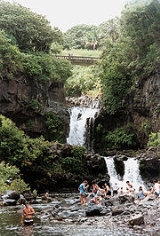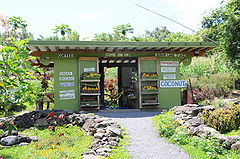
Kipahulu
Encyclopedia
Kīpahulu is a village in the Hāna district of Maui
, Hawaii
. It is a sustainable farm community located in a remote area in the southeast part of Maui.
and east of Kaupō
. The only land access to the area is from north by Hana Highway
driving about 45 minutes past Hāna or from west by highway 31 (Piilani Highway) which has recently reopened after it was closed for a period of time due to earthquake damage. Piilani Highway is the only major road in Kīpahulu and all populated areas are located along this road.
Kīpahulu currently does not have any electric or water utilities. The only public utility is the telephone
. Water is obtained from the streams coming down from Haleakalā
and these services are provided to the community by Kaupo Ranch, Ltd.
in 1786 while sailing along the southeast coast of Maui in search of a place to drop anchor:
Kīpahulu lowlands were once heavily populated. The area held hundreds of farm sites and agricultural terraces that could support hundreds of people. It was formerly the center of one of the old land districts (moku). In nearby coastal area surveys, over 700 archeological features have been found in the 2008 acres (8.1 km²) surveyed thus far. The features consist of stone mounds and walls and earthen terraces.
Coastal villages consisted of housing clusters for extended families (Hawaiian: ohana
) and included living quarters, cook houses, and sheds used for work, storage, and canoes. More dwellings, used occasionally, were located farther upland throughout the cultivated area. All structures were single story, one room wood frame buildings with thatched walls and roofs. Small stone shrines were associated with village sites.
With the development of the whaling industry on the island in 1880s Kīpahulu population started to decline as people moved to main whaling ports like Lāhainā
.
In the early 1900s, one of the regular ports of call
for the Inter-Island Steam Navigation Company
was Kīpahulu. Steamships provided passenger service around Maui and between the islands. Kīpahulu Landing also provided a way for growers and ranchers to ship their goods to markets. Today the land where Kīpahulu Landing existed is private but protected by The Nature Conservancy
.
| |
|
|
|}>
was established as a separate unit of the National Park System in 1960 (it was previously joined with Hawaii National Park on Hawaii Island). At the time, the park only consisted of the crater area of Haleakalā. On March 26, 1951, Kīpahulu Valley was added to Haleakalā National Park (HNP) as the Kīpahulu Biological Reserve to insure protection of endangered ecosystems within the sanctuary. Eighteen years later on January 10, 1969, the HNP boundaries were expanded to include the Kīpahulu coastal area of Oheo .
Although access in the Kīpahulu Biological Reserve is strictly limited to researchers and managers, the Oheo region of the park is open for recreation. Attractions include the Oheo Pools, often called the "Seven Sacred Pools" (a name created by tourism proponents), a car-accessible campground, and several maintained trails, such as the four-mile Pipiwai Loop Trail to Waimoku waterfall. The Kīpahulu Ohana, a non-profit community organization established in 1995 through a co-operative agreement with Haleakalā National Park to revive, restore, and share the practices of traditional Native Hawaiian culture, also conducts community-based cultural tours in the area.
Maui
The island of Maui is the second-largest of the Hawaiian Islands at and is the 17th largest island in the United States. Maui is part of the state of Hawaii and is the largest of Maui County's four islands, bigger than Lānai, Kahoolawe, and Molokai. In 2010, Maui had a population of 144,444,...
, Hawaii
Hawaii
Hawaii is the newest of the 50 U.S. states , and is the only U.S. state made up entirely of islands. It is the northernmost island group in Polynesia, occupying most of an archipelago in the central Pacific Ocean, southwest of the continental United States, southeast of Japan, and northeast of...
. It is a sustainable farm community located in a remote area in the southeast part of Maui.
Location and access
Kīpahulu is unincorporated and is located in the southeastern part of Maui, south of HānaHana
Hana as a given name may have several origins. It is a variant transliteration of Hannah, meaning Grace in Hebrew associated with God feminine which is the Jewish and Christian form, as well as an Arabic female name meaning happiness , a Persian female name meaning a type of flower , and a Kurdish...
and east of Kaupō
Kaupo, Hawaii
Kaupo is one of the districts of ancient Hawaii of Maui island in Hawaii. Kaupo is a very remote and sparsely populated sustainable ranching community.- Location :...
. The only land access to the area is from north by Hana Highway
Hana Highway
The Hāna Highway is a long stretch of Hawaii State Routes 36 and 360 which connects Kahului with the town of Hāna in east Maui. On the east after Kalepa bridge, Hana Highway continues to Kīpahulu as Route 31 , the first section of which is unofficially considered to be part of Hāna Highway...
driving about 45 minutes past Hāna or from west by highway 31 (Piilani Highway) which has recently reopened after it was closed for a period of time due to earthquake damage. Piilani Highway is the only major road in Kīpahulu and all populated areas are located along this road.
Kīpahulu currently does not have any electric or water utilities. The only public utility is the telephone
Telephone
The telephone , colloquially referred to as a phone, is a telecommunications device that transmits and receives sounds, usually the human voice. Telephones are a point-to-point communication system whose most basic function is to allow two people separated by large distances to talk to each other...
. Water is obtained from the streams coming down from Haleakalā
Haleakala
Haleakalā , or the East Maui Volcano, is a massive shield volcano that forms more than 75% of the Hawaiian Island of Maui. The western 25% of the island is formed by the West Maui Mountains.- History :...
and these services are provided to the community by Kaupo Ranch, Ltd.
History
The first written description of Kīpahulu was made by La PérouseJean-François de Galaup, comte de La Pérouse
Jean François de Galaup, comte de Lapérouse was a French Navy officer and explorer whose expedition vanished in Oceania.-Early career:...
in 1786 while sailing along the southeast coast of Maui in search of a place to drop anchor:
I coasted along its shore at a distance of a leagueLeague (unit)A league is a unit of length . It was long common in Europe and Latin America, but it is no longer an official unit in any nation. The league originally referred to the distance a person or a horse could walk in an hour...
(three miles) …. We beheld water falling in cascades …. The inhabitants, which are so numerous that a space of 3–4 leagues may be taken for a single village. The huts are on the coast so that the habitable part of the island is less than one half of a league. After passing Kaupō no more waterfalls are seen, and villages are fewer.
Kīpahulu lowlands were once heavily populated. The area held hundreds of farm sites and agricultural terraces that could support hundreds of people. It was formerly the center of one of the old land districts (moku). In nearby coastal area surveys, over 700 archeological features have been found in the 2008 acres (8.1 km²) surveyed thus far. The features consist of stone mounds and walls and earthen terraces.
Coastal villages consisted of housing clusters for extended families (Hawaiian: ohana
Ohana
Part of Hawaiian culture, ohana means family in an extended sense of the term, including blood-related, adoptive or intentional. It emphasizes that family are bound together and members must cooperate and remember one another...
) and included living quarters, cook houses, and sheds used for work, storage, and canoes. More dwellings, used occasionally, were located farther upland throughout the cultivated area. All structures were single story, one room wood frame buildings with thatched walls and roofs. Small stone shrines were associated with village sites.
With the development of the whaling industry on the island in 1880s Kīpahulu population started to decline as people moved to main whaling ports like Lāhainā
Lahaina, Hawai'i
Lāhainā is the largest census-designated place in West Maui, Maui County, Hawaii, United States, and the gateway to the famous Kaanapali and Kapalua beach resorts north of the community. As of the 2000 Census, the CDP had a resident population of 9,118...
.
In the early 1900s, one of the regular ports of call
Port of Call
-Synopsis:Berit, a young woman living in a working-class port town begins a relationship with Gösta, a sailor newly returned from overseas and intent upon staying on land...
for the Inter-Island Steam Navigation Company
Inter-Island Steam Navigation Company
Inter-Island Steam Navigation Company was the company headquartered in Honolulu that ran steam boat service between Hawaiian cities from 1883 until 1947. On January 30, 1929 company founded the subsidiary company Inter-Island Airways that was later renamed to Hawaiian Airlines...
was Kīpahulu. Steamships provided passenger service around Maui and between the islands. Kīpahulu Landing also provided a way for growers and ranchers to ship their goods to markets. Today the land where Kīpahulu Landing existed is private but protected by The Nature Conservancy
The Nature Conservancy
The Nature Conservancy is a US charitable environmental organization that works to preserve the plants, animals, and natural communities that represent the diversity of life on Earth by protecting the lands and waters they need to survive....
.
Attractions
- Grave of the aviator Charles LindberghCharles LindberghCharles Augustus Lindbergh was an American aviator, author, inventor, explorer, and social activist.Lindbergh, a 25-year-old U.S...
who is buried on the grounds of Palapala Hoomau Church - Kīpahulu district of the Haleakala National ParkHaleakala National ParkHaleakalā National Park is a United States national park located on the island of Maui in the state of Hawaii. The park covers an area of , of which is a wilderness area...
with seven pools in ʻOheʻo Gulch - Pipiwai hiking trail leading to 400 feet (121.9 m) Waimoku Falls
- Laulima Farms tropical fruit stand with the bicycle-powered blender. In August 2011 Hauaii Health Department closed Laulima farm due to the lack of license.
|

|
|}>
Haleakalā National Park
Haleakalā National ParkHaleakala National Park
Haleakalā National Park is a United States national park located on the island of Maui in the state of Hawaii. The park covers an area of , of which is a wilderness area...
was established as a separate unit of the National Park System in 1960 (it was previously joined with Hawaii National Park on Hawaii Island). At the time, the park only consisted of the crater area of Haleakalā. On March 26, 1951, Kīpahulu Valley was added to Haleakalā National Park (HNP) as the Kīpahulu Biological Reserve to insure protection of endangered ecosystems within the sanctuary. Eighteen years later on January 10, 1969, the HNP boundaries were expanded to include the Kīpahulu coastal area of Oheo .
Although access in the Kīpahulu Biological Reserve is strictly limited to researchers and managers, the Oheo region of the park is open for recreation. Attractions include the Oheo Pools, often called the "Seven Sacred Pools" (a name created by tourism proponents), a car-accessible campground, and several maintained trails, such as the four-mile Pipiwai Loop Trail to Waimoku waterfall. The Kīpahulu Ohana, a non-profit community organization established in 1995 through a co-operative agreement with Haleakalā National Park to revive, restore, and share the practices of traditional Native Hawaiian culture, also conducts community-based cultural tours in the area.

